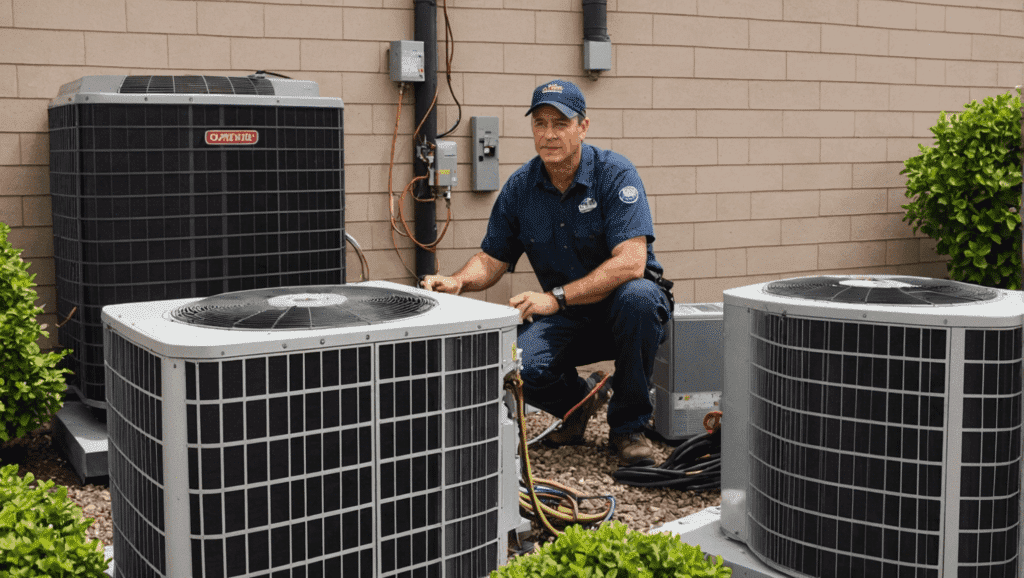Every homeowner knows the panic of discovering water damage from a malfunctioning appliance. When it comes to your air conditioning system, the overflow switch serves as your first line of defense against costly water damage. This small but vital component quietly protects your home while you sleep, work, and go about your daily life. Understanding how your float switch functions could save you thousands in water damage repairs and prevent unnecessary AC system failures.

Understanding the Overflow Switch: Your AC’s Safety Net
An float switch is a simple yet ingenious device designed to monitor water levels in your AC’s drain pan. When condensation builds up due to a clogged drain line or pump failure, the overflow switch activates to shut down your AC system before water can spill over and damage your home. Think of it as the emergency shutoff valve for your air conditioner’s drainage system.
As highlighted in the article AC Repair: Ensuring Comfort and Efficiency for Every Home, proper maintenance of safety components like your overflow switch is just as important as servicing the mechanical parts of your system. A functioning overflow switch can mean the difference between a simple drain line cleaning and extensive water damage repairs.
How Your Overflow Switch Protects Your Home and AC System
Your float switch provides multiple layers of protection that many homeowners don’t realize until it’s too late:
First and foremost, it prevents water damage to your ceilings, walls, and flooring. When an AC drain line clogs (which happens more frequently than most people realize), condensation has nowhere to go except your drain pan. Without an overflow switch, this water would eventually spill over, potentially causing thousands in damage before being discovered.
Second, it protects your HVAC equipment from water damage. Electrical components in your AC system, including your air handler and control boards, can be ruined by water exposure. The cost to replace these components often exceeds the price of a new overflow switch many times over.
Third, it helps prevent mold growth. Standing water from AC overflow creates ideal conditions for mold and mildew, which can cause health problems and require expensive remediation. A properly functioning float switch eliminates this risk by preventing overflow situations entirely.
Common Problems With Overflow Switches
While overflow switches are relatively simple devices, several issues can affect their performance:
The most common problem is a clogged drain line causing frequent activation. When your overflow switch keeps shutting off your AC, it’s actually working as designed – alerting you to a drainage problem that needs attention. Many homeowners mistakenly blame the switch when the real issue lies in the drain line.
Another frequent issue is improper installation. If your overflow switch isn’t positioned at the correct height in the drain pan, it may activate too soon (creating unnecessary system shutdowns) or too late (allowing water to overflow). This is why professional installation during routine AC Maintenance is so important.
Corrosion and mineral buildup can also affect performance. Over time, exposure to moisture and condensation can cause the switch mechanism to stick or fail completely. This is particularly common in areas with hard water or high humidity.
The True Cost of Ignoring Your Overflow Switch
Neglecting your overflow switch can lead to several expensive consequences that go beyond simple AC repairs:
Water damage repairs often cost thousands of dollars, especially if the overflow occurs on an upper floor and damages ceilings below. Unlike sudden pipe bursts, AC leaks often happen gradually, causing damage over time before being discovered.
Mold remediation is another potential cost. According to EPA guidelines, professional mold removal averages between 500and6,000 depending on the extent of contamination. Many homeowners insurance policies have limited coverage for mold damage.
Equipment replacement costs can be substantial. Water exposure can ruin electrical components in your AC system, damage your Lineset for AC, and even compromise structural elements of your HVAC system. These repairs often cost significantly more than the price of a new overflow switch and proper maintenance.
Proper Maintenance for Your Overflow Switch
Maintaining your overflow switch is relatively simple but critically important for system protection:
Regular testing should be part of your seasonal HVAC maintenance. At least twice a year (before cooling and heating seasons), manually activate the switch to ensure it properly shuts off your system. If it fails to trigger a shutdown, you need immediate AC Repair Service.
Keep drain lines clear. Pouring a cup of vinegar down your AC drain line monthly helps prevent clogs that could trigger your overflow switch. For homes with particularly problematic drainage, consider installing a Safety Float Switch as secondary protection.
Check for proper positioning during professional AC Maintenance visits. Your technician should verify the switch activates before water reaches the top of the drain pan but not so early that it causes unnecessary system shutdowns.
When to Call a Professional
While basic overflow switch maintenance can be DIY, certain situations require professional attention:
If your switch activates frequently (more than once a month), you likely have a drainage problem that needs professional diagnosis and repair.
If water appears around your indoor unit but the switch hasn’t activated, you may need a new overflow switch or additional protection installed.
If you’re unsure whether your system even has an overflow switch, schedule an inspection – especially important if your AC is more than 10 years old.
For homes that use both AC and heating systems like those installed by a Split AC Installer Near Me, ensuring proper drainage and overflow protection is doubly important as both systems produce condensation.
The Connection Between Your Overflow Switch and System Efficiency
Your float switch affects more than just water containment – it impacts your entire system’s performance:
Proper drainage ensured by a working overflow switch helps maintain optimal humidity levels in your home, improving comfort and efficiency.
A malfunctioning switch that constantly shuts off your AC can put extra strain on your compressor when the system tries to restart, reducing its lifespan.
Water overflow can damage not just your home but also components like your Vents AC system, leading to reduced airflow and efficiency throughout your home.
Upgrading Your Overflow Protection
Modern float protection systems offer features older models don’t:
Electronic sensors can detect water presence without moving parts, reducing the chance of mechanical failure.
Wi-Fi enabled switches can alert your phone when activated, allowing you to address problems before they cause damage.
Some models include secondary switches for extra protection in case the primary fails.
If your AC is more than 10 years old, consider asking your HVAC professional about upgrading your overflow switch during your next AC Maintenance visit.
Seasonal Considerations for Your Overflow Switch
Your overflow switch needs attention year-round, not just during cooling season:
Before cooling season begins, test your switch and clear drain lines to handle increased condensation.
During periods of high humidity, check your drain pan more frequently as your AC will produce more condensation.
If you switch between AC and heating seasonally, ensure both systems’ drainage is functioning properly.
In winter, if you live in a cold climate, make sure your drain lines don’t freeze, which could cause backup and trigger your overflow switch.
Taking Action on Overflow Switch Issues
If you suspect problems with your float switch, take these steps:
First, locate your switch (usually in the drain pan near your indoor unit) and test it manually.
Check for visible water in or around the drain pan when your AC is running.
Listen for unusual gurgling sounds from your drain line, which could indicate a partial clog.
If you’re unsure about any of these checks or find problems, Contact Us for professional assistance. A small investment in overflow switch maintenance can prevent enormous repair bills down the road.
Remember, your overflow switch works silently in the background to protect your home. By giving it proper attention, you’ll avoid costly water damage and keep your AC running smoothly all season long. Whether you’re maintaining an existing system or working with a Split AC Installer Near Me on a new installation, never underestimate the importance of this small but critical component.




